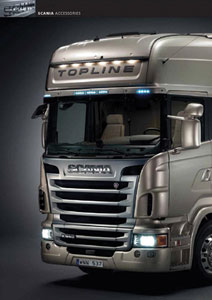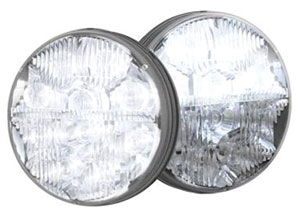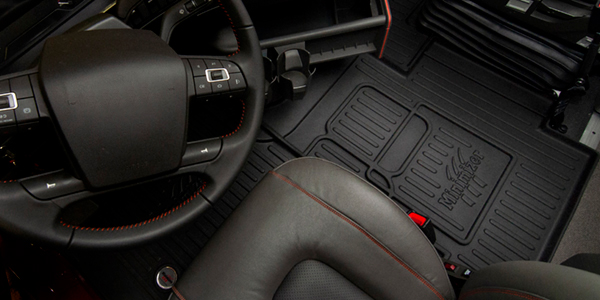 The efficiencies enjoyed by fleets using LED stop-turn-tail and marker lights have economy-minded managers pressing lamp suppliers for white LEDs, and they’re coming. They just aren’t quite as inexpensive as they need to be to make them competitive in many applications.
The efficiencies enjoyed by fleets using LED stop-turn-tail and marker lights have economy-minded managers pressing lamp suppliers for white LEDs, and they’re coming. They just aren’t quite as inexpensive as they need to be to make them competitive in many applications.
But why aren’t they? If they can make colored LEDs, why not simply make a white one? What, if anything, makes white LEDs different from amber or red devices?
You’ll be able to answer that question yourself if you can remember something from your art or general science class in junior high or high school. In art, you likely learned that the color white is made up of all the other colors. In general science, the teacher took a prism and let a small beam of white light pass through it to demonstrate how white light is made up of all the colors of the visible spectrum.
To answer what makes white LEDs different from colored devices, you also need to know that LEDs produce light of a pure color—red, blue, green etc.—color of a single wave length. Since white is made up of all visible wave lengths, a single LED simply cannot produce white light—without some help.
What to do? The answer was found as recently as a decade ago by a Japanese researcher. This was an advance that was critical to progress with the development of white LEDs and one that was quickly developed further. Brad Van Riper, senior vice president and chief technology officer at Truck-Lite, says, “As recently as eight years ago, I would have expressed doubts that white LEDs would be available in 2010 or even that we would ever have white LEDs. White LED light comes from the use of a blue LED and a phosphor coating—much like that which is used in fluorescent tubes. The phosphor, when illuminated by the blue LED light, will release light that fills out the spectrum.” The result is a white emitting LED.
White LED technology has progressed currently to where developers are putting a ceramic coating on the surface of the blue emitting LED that contains a very uniform thickness of phosphor. This has greatly improved the uniformity of white LED color. Van Riper says, “Currently, phosphor technology is advancing and is making available tuned light colors much like what you find from fluorescent tubes.”
To actually incorporate white LEDs into an automotive application, rather complex driver circuitry is required. A major technical challenge is dissipating the heat generated by this circuitry. While there is little or no heat associated directly with the white LEDs, there is heat produced by the package that must be dissipated. LED lamps are known for their exceptionally long life spans, particularly in comparison to incandescent, halogen and xenon lamps. However, an LED lamp with inadequate heat dissipation characteristics can fail prematurely.
The objective is to efficiently conduct heat away from the LED’s most vulnerable point—the junction of its wire bond and its silicone chip. Lamp suppliers handle this problem in different ways. Scott Robertson, product manager of Grote’s white light program, says, “We generally use thermally conducting potting material to take the heat away from the LED and into the lamp housing and then out into the atmosphere or environment. If you come across a high powered LED lamp that’s cool to the touch, it’s probably cooking on the inside.”

New developments
High intensity or high brightness white LEDs are receiving a great deal of attention currently by product development engineers. Lamp efficiency is measured in lumens per watt, a unit that measures the amount of light that is produced for the amount of electricity that is put into the lamp.
Most LED manufacturers can achieve over 100 lumens per watt. Some can realize as much a 200 lumens per watt in the laboratory, a figure researchers believe to be about the upper limit for LEDs. It will, of course, be a while before we see such devices in the consumer market, but the technology exists to build ultra efficient white LEDs. Nathan Taylor, a project engineer at Peterson Manufacturing, says, “What’s in the lab today is maybe three years away from the market. I’d say that in three to five years we’ll be seeing 200 lumens per watt LEDs in the consumer market.”
The greatest push for white LED development is actually coming from companies interested in commercial lighting of retail stores and factories. This, of course, is because of the potential savings offered by LEDs. The U.S. Department of Energy has invested quite a bit of resources in projects to accelerate the development of LED lighting. There is actually a move to sequentially eliminate the long familiar incandescent light bulb. Truck-Lite’s Van Riper says, “The 100 watt will be the first to be eliminated, then the 75 watt, etc. By 2014, the incandescent light bulb will probably disappear to be replaced by your choice of compact fluorescents or LEDs.”
Automotive applications
When white LEDs first became available, suppliers started offering products like license plate and convenience lights for inside sleepers. As output increased, they moved on to backup and work lights. The next obvious frontier was forward lighting. Truck-Lite’s Van Riper says, “We knew we would have to target a standardized solution in order to make economic sense, so we selected the seven-inch round head lamp. The 24-volt incandescent version of that product had a B50 life of just 400 hours. The military, therefore, was very interested in a reliable 24-volt headlamp. As a result, we were awarded funding to develop the product. Since then we’ve sold about a quarter of a million to the government. We’ve also launched a 12-volt version for commercial applications.”
LED technology has advanced to a point where an entire truck could be outfitted with LEDs. It could be done, but it would still be a costly option in the most desirable applications, forward lighting in particular. However, this same situation existed when red and amber stop-turn-tail LEDs were first introduced.
Regarding LED headlights, Grote’s Robertson says, “The cost of white LEDs has come down, but it’s not like buying a standard light bulb. It’s a sophisticated piece of electronics. It’s still a question whether LED headlights offer any economic advantage, even over the life of a truck. Halogen lamps are probably the easiest part to replace on a vehicle and are very readily available. Drivers can easily carry a spare in their cabs. The price point is not there yet for headlights at this time.”
But there’s hope. Peterson’s Taylor says, “High powered white LEDs for the front of a truck were originally quite expensive. They’re coming down in price now so there are some options in the market for fog lights and that sort of thing. However, more common are work lights, applications that don’t have a specific legal requirement. There are a few headlamp products already making an appearance in the market. There’s certainly a lot of work taking place in the industry on forward LED lighting in general. At the moment, just as stop-turn-tail lights were early on, they’re still something of an oddity. But they’re closing the gap.”
Grote is currently working on a daytime running light program for Scania in Europe, where running lights are required on all trucks. Robertson says, “A lot of work has been done to get that light into a plastic housing while keeping the heat generated under control. To do that, efforts need to be directed at developing very efficient driver circuitry.”
Regulations
FMVSS 108 is the federal regulation dealing with the lights used on trucks, and today’s white LED head lights can comply with this standard. The only legal requirement is to put the light of the correct color and intensity in the right place. As Peterson’s Taylor says, “It will take more LEDs to make a head light than a stop light, but they can certainly be legal. There’s nothing about an LED that makes it intrinsically legal or illegal.”
Studies are being conducted at the University of Michigan’s Transportation Research Institute on the effects of changing FMVSS 108 from an equipment based standard to a performance based standard. Such a change should significantly reduce many technical aspects in the regulations. Kristen Goodson, director of product management at Peterson, says, “NHTSA is considering a change in lighting regulations that will move the compliance requirement from the manufacturer of the lamp to the OEM of the truck. The regulations will then apply to lighting when installed in a vehicle as opposed to the unmounted lamp.”
The market is looking for ways to utilize more highly performing products and LEDs certainly fall into that category since they offer energy efficiency, long life and demand only low amperage.




